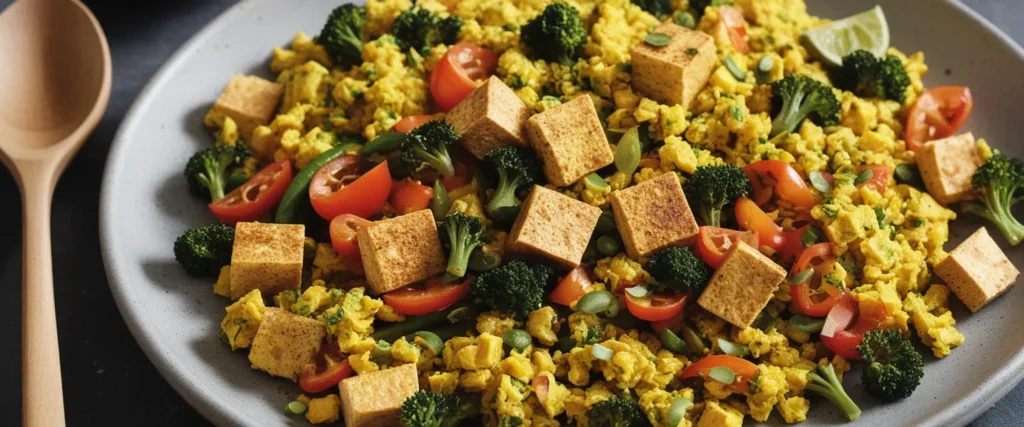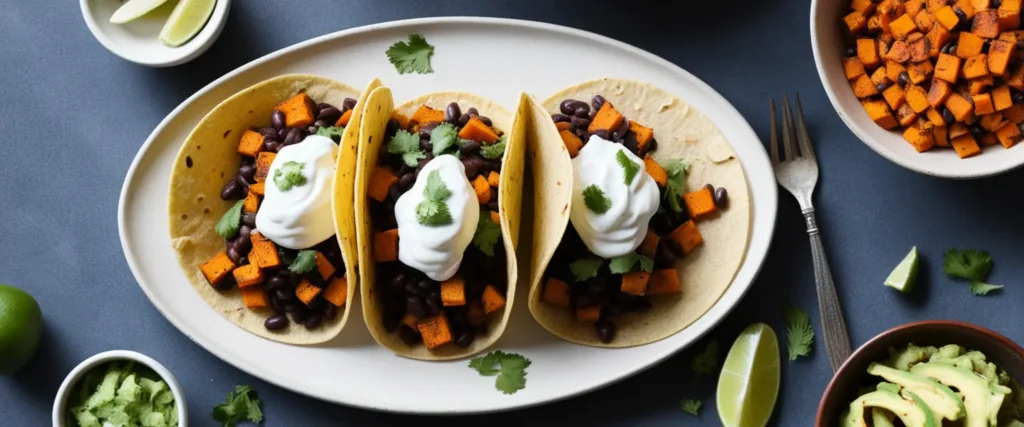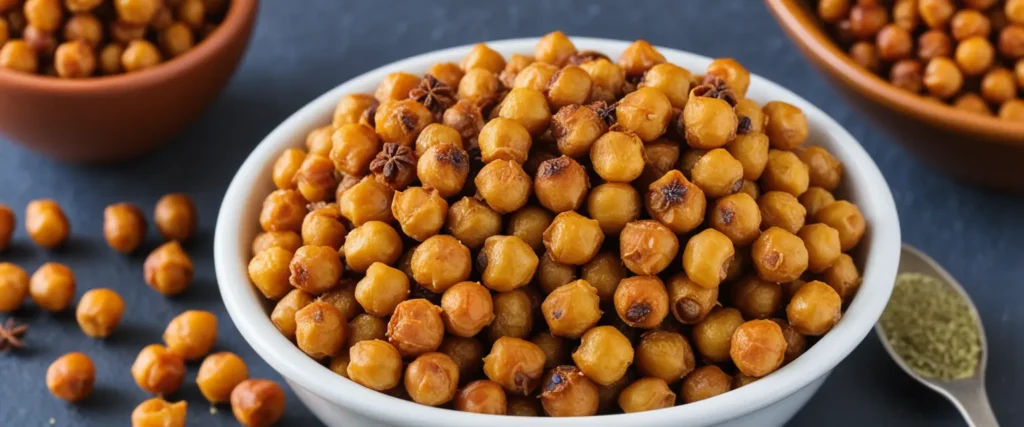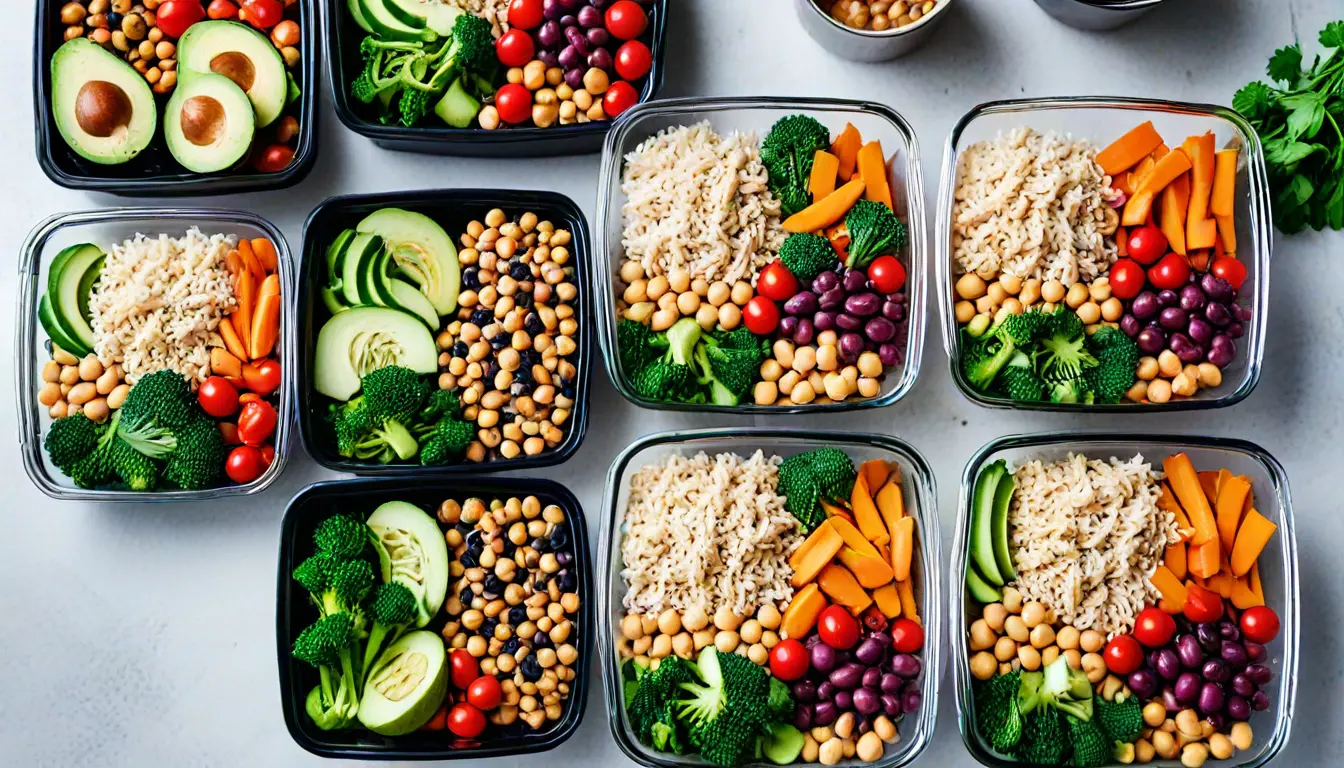Introduction to Vegan Meal Prep Ideas
If you want to enjoy healthy and tasty Vegan Meal Prep Ideas every day, it is a great idea to include vegan meal prep ideas in your weekly routine. Vegans must prepare their meals by using only plant-based foods including whole fruits, vegetables, grains, nuts and legumes. It also helps one to cook quickly while promoting sustainable living and morality.
What is Vegan Meal Prep?
Meal prepping as a vegan means preparing food in advance with plant-based emphasis. This could be cooking whole meals or chopping veggies or portioning out snacks or preparing grains and legumes. What this does is simplify the process of eating well and limit impulsive eating habits.
Benefits of Vegan Meal Prep Ideas for Health and Lifestyle
- Improved Health: A vegan diet rich in whole foods is linked to numerous health benefits, including reduced risk of chronic diseases like heart disease, diabetes, and certain cancers. Meal prepping ensures you have nutritious options readily available, helping you maintain a balanced diet.
- Weight Management: Planning and portioning your meals in advance helps control calorie intake, making it easier to achieve weight loss or maintenance goals.
- Sustainability: Embracing a vegan lifestyle supports environmental sustainability by reducing your carbon footprint and conserving resources.
- Stress Reduction: Knowing you have healthy meals ready to go eliminates the stress of deciding what to eat every day, especially during busy weekdays.
How Vegan Meal Prep Ideas Prep Saves Time and Money
- Time Efficiency: Dedicate one or two days a week to meal prep, and you’ll spend less time cooking and cleaning during the week. Batch cooking and multitasking during prep sessions maximize efficiency.
- Cost Savings: Buying ingredients in bulk and reducing food waste through careful planning can significantly cut grocery costs. Plus, preparing meals at home is generally more affordable than dining out.
Getting Started with Vegan Meal Prep Ideas
Essential Tools and Equipment for Meal Prepping

To get started with vegan meal prep, having the right tools and equipment is crucial. Here are some essentials:
- Storage Containers: Invest in high-quality, reusable containers of various sizes to store meals and ingredients. Look for BPA-free, microwave-safe options.
- Blender or Food Processor: These appliances are invaluable for making smoothies, sauces, and plant-based dips.
- Sharp Knives and Cutting Boards: Efficient chopping is key to quick meal prep, so ensure you have a reliable set of knives and sturdy cutting boards.
- Cooking Essentials: A large pot, skillet, and baking sheets will help you cook multiple dishes simultaneously.
Pantry Staples for a Vegan Kitchen
Stocking your pantry with versatile vegan staples ensures you always have the ingredients needed for meal prep:
- Grains: Brown rice, quinoa, oats, and whole-grain pasta.
- Legumes: Lentils, chickpeas, black beans, and kidney beans.
- Nuts and Seeds: Almonds, chia seeds, flaxseeds, and walnuts.
- Spices and Herbs: Cumin, turmeric, basil, and oregano.
- Condiments: Soy sauce, nutritional yeast, tahini, and apple cider vinegar.
Tips for Planning a Weekly Vegan Meal Prep Ideas Routine
- Create a Menu: Plan a variety of meals to avoid monotony. Include breakfast, lunch, dinner, and snacks in your plan.
- Grocery List: Based on your menu, create a detailed grocery list to ensure you have all necessary ingredients on hand.
- Batch Cooking: Prepare larger quantities of grains, beans, and roasted vegetables that can be mixed and matched throughout the week.
- Use a Planner: Keep a meal prep planner or app to track your meals and note any adjustments for future weeks.
Understanding Vegan Nutrition
Ensuring you meet all your nutritional needs on a vegan diet is essential for maintaining good health.
Key Nutrients in a Vegan Diet
- Protein: Obtainable from legumes, tofu, tempeh, and quinoa.
- Iron: Found in lentils, spinach, and fortified cereals.
- Calcium: Sources include fortified plant milks, almonds, and leafy greens.
- Vitamin B12: Essential for nerve health, found in fortified foods or supplements.
- Omega-3 Fatty Acids: Sourced from flaxseeds, chia seeds, and walnuts.
How to Ensure a Balanced Vegan Diet
To ensure a well-rounded vegan diet, focus on:
- Diversity: Include a wide variety of foods to cover all nutrient bases.
- Fortified Foods: Choose fortified plant milks and cereals to boost nutrient intake.
- Supplements: Consider taking supplements for nutrients like B12 and vitamin D, as needed.
Common Vegan Nutritional Deficiencies and How to Avoid Them
- Vitamin B12: Since it’s primarily found in animal products, it’s important to consume fortified foods or take a supplement.
- Iron Deficiency: Pair iron-rich foods with vitamin C sources (like citrus fruits) to enhance absorption.
- Calcium Shortage: Incorporate plenty of calcium-rich foods and consider fortified options.
- Protein Intake: Ensure you’re consuming enough protein through a variety of plant-based sources.
By following these easy vegan meal prep ideas and tips, you can enjoy a healthy, balanced, and stress-free week of plant-based eating. Embrace the benefits of vegan meal prep and transform your lifestyle with delicious, nutritious meals that support your well-being and the planet.
Vegan Meal Prep Breakfast Ideas
Starting your day with a nutritious vegan breakfast can set the tone for a healthy and energetic day. Plant-based breakfasts are not only delicious and satisfying but also packed with essential nutrients that fuel your body. Here are some easy and creative vegan breakfast ideas to kickstart your morning.
Overnight Oats with Fruits and Nuts

Overnight oats are a convenient and versatile breakfast option that can be prepared ahead of time, allowing you to grab a nutritious meal on the go. To make overnight oats, combine rolled oats with your choice of plant-based milk or yogurt and let them soak overnight in the refrigerator. In the morning, add a variety of toppings to boost flavor and nutrition:
- Fruits: Fresh berries, sliced bananas, diced apples, or mango chunks provide natural sweetness and a dose of vitamins and antioxidants.
- Nuts and Seeds: Almonds, walnuts, chia seeds, and flaxseeds add a satisfying crunch and are excellent sources of healthy fats and protein.
- Spices and Sweeteners: Enhance the flavor with a pinch of cinnamon or nutmeg, and if desired, add a drizzle of maple syrup or agave nectar for extra sweetness.
Overnight oats are incredibly adaptable, allowing you to experiment with different flavor combinations and seasonal ingredients to keep your breakfast exciting.
Smoothie Packs for Quick Blends

Smoothies are a quick and refreshing way to enjoy a nutrient-rich breakfast, and preparing smoothie packs in advance makes it even more convenient. To create smoothie packs:
- Choose Your Base: Start with a liquid base such as almond milk, coconut water, or fresh juice. Freeze in individual portions for easy use.
- Select Your Fruits: Berries, bananas, and tropical fruits like pineapple or mango are great choices for a naturally sweet and flavorful smoothie.
- Add Veggies: Incorporate leafy greens like spinach or kale for an added boost of vitamins and minerals.
- Boost with Extras: Include superfoods like chia seeds, hemp seeds, or a scoop of plant-based protein powder for added nutrition.
To prepare, simply blend the contents of a smoothie pack with your chosen liquid base in the morning. These pre-portioned packs save time and ensure you get a balanced breakfast rich in fiber, vitamins, and antioxidants.
Tofu Scramble with Vegetables and Spices

Tofu scramble is a savory and protein-packed alternative to traditional scrambled eggs, offering a hearty and satisfying breakfast option. Here’s how to make a delicious tofu scramble:
- Crumble the Tofu: Use firm or extra-firm tofu, and crumble it into small pieces to mimic the texture of scrambled eggs.
- Add Vegetables: Sauté a colorful array of vegetables such as bell peppers, onions, mushrooms, and spinach for added nutrients and flavor.
- Season Generously: Use spices like turmeric, cumin, and paprika to add depth and color to the dish. Nutritional yeast can also be added for a cheesy flavor.
- Serve and Enjoy: Pair your tofu scramble with whole-grain toast, avocado slices, or roasted potatoes for a complete and satisfying meal.
Tofu scramble is highly customizable, allowing you to incorporate your favorite vegetables and spices to suit your taste preferences. It’s an excellent way to enjoy a protein-rich breakfast that keeps you full and energized throughout the morning.
Vegan Meal Prep Dinner Ideas
Creating satisfying and flavorful vegan dinners is easier than you might think. With the right ingredients and a bit of creativity, you can prepare meals that are both nutritious and delicious. Here are three vegan dinner ideas to inspire your next meal.
Black Bean and Sweet Potato Tacos

Black bean and sweet potato tacos are a hearty and flavorful dinner option that’s sure to please. Packed with nutrients and vibrant flavors, these tacos are easy to prepare and perfect for a quick weeknight meal.
- Sweet Potatoes: Roast or sauté diced sweet potatoes until they are tender and slightly caramelized. Sweet potatoes add a natural sweetness and a boost of vitamins A and C.
- Black Beans: Black beans provide a rich source of plant-based protein and fiber, making these tacos filling and satisfying. You can season the beans with cumin, chili powder, and garlic for extra flavor.
- Toppings: Top your tacos with fresh ingredients like diced tomatoes, avocado slices, chopped cilantro, and a squeeze of lime juice for brightness. You can also add pickled onions or a dollop of vegan sour cream for added tang.
- Tortillas: Use corn or flour tortillas to wrap your ingredients, and enjoy the combination of flavors and textures in each bite.
These black bean and sweet potato tacos are not only delicious but also packed with nutrients, making them a perfect choice for a healthy vegan dinner.
Stir-Fried Tofu with Broccoli and Cashews

Stir-fried tofu with broccoli and cashews is a quick and easy dish that delivers a satisfying mix of flavors and textures. This dish is not only tasty but also rich in protein and essential nutrients.
- Tofu: Use firm or extra-firm tofu, and cut it into bite-sized cubes. Pan-fry the tofu until golden and crispy on the outside for a delightful texture.
- Broccoli: Add fresh broccoli florets to the pan, and stir-fry until they are bright green and tender-crisp. Broccoli is an excellent source of vitamins K and C, as well as fiber.
- Cashews: Toss in a handful of cashews for a crunchy element and a boost of healthy fats and protein.
- Sauce: Create a savory sauce using soy sauce, garlic, ginger, and a touch of sesame oil. Pour the sauce over the tofu and broccoli, allowing the flavors to meld together.
Serve this stir-fry over a bed of steamed rice or quinoa for a complete and balanced meal that’s ready in no time.
Spaghetti with Avocado Pesto Sauce

Spaghetti with avocado pesto sauce is a creamy and delicious pasta dish that offers a unique twist on traditional pesto. This vegan dinner idea is both satisfying and easy to prepare.
- Avocado Pesto: Blend ripe avocados with fresh basil, garlic, lemon juice, and a sprinkle of nutritional yeast for a creamy and flavorful sauce. Avocados add a luscious texture and are rich in healthy fats.
- Spaghetti: Cook your favorite spaghetti or pasta according to package instructions, and toss it with the avocado pesto until well-coated.
- Add-Ins: Enhance the dish with cherry tomatoes, sautéed mushrooms, or spinach for added nutrition and flavor. You can also sprinkle some toasted pine nuts or walnuts for a bit of crunch.
- Garnish: Top the pasta with fresh basil leaves and a dash of red pepper flakes for a hint of spice.
This avocado pesto spaghetti is a delightful vegan dinner option that’s both creamy and full of fresh flavors, making it a perfect choice for a cozy evening meal.
Vegan Meal Prep Snack Ideas
Finding satisfying and nutritious vegan snacks is easy with a little creativity and preparation. Whether you’re looking for something to munch on between meals or a healthy treat to fuel your day, these vegan snack ideas are both delicious and convenient.
Homemade Granola Bars

Homemade granola bars are a perfect on-the-go snack that you can customize to suit your taste preferences. Packed with whole grains, nuts, and dried fruits, these bars are nutritious and filling.
- Oats: Use rolled oats as the base for your granola bars. Oats are rich in fiber and provide a slow-release energy source.
- Nuts and Seeds: Add a mix of almonds, walnuts, chia seeds, or flaxseeds for protein and healthy fats. These ingredients give the bars a satisfying crunch.
- Dried Fruits: Incorporate dried cranberries, apricots, or raisins for natural sweetness and a burst of flavor.
- Sweeteners and Bindings: Use natural sweeteners like maple syrup or agave nectar, and a nut butter such as almond or peanut butter to bind the ingredients together.
- Baking: Press the mixture into a lined baking dish, bake until set, and allow to cool before cutting into bars.
These homemade granola bars are perfect for a quick snack, offering a delicious combination of flavors and textures that will keep you energized throughout the day.
Hummus and Vegetable Sticks

Hummus paired with fresh vegetable sticks is a classic vegan snack that is both nutritious and satisfying. This combination provides a balance of protein, fiber, and essential nutrients.
- Hummus: Make your own hummus by blending chickpeas, tahini, lemon juice, garlic, and olive oil until smooth. For variety, you can add roasted red peppers, sun-dried tomatoes, or herbs like cilantro or basil for extra flavor.
- Vegetable Sticks: Cut a variety of fresh vegetables into sticks or wedges. Popular choices include carrots, celery, cucumber, bell peppers, and cherry tomatoes. These vegetables add a refreshing crunch and are packed with vitamins and minerals.
- Presentation: Arrange the vegetable sticks on a platter with a bowl of hummus in the center for a colorful and inviting snack display.
Hummus and vegetable sticks are not only healthy but also incredibly easy to prepare, making them a go-to snack option for any time of the day.
Roasted Chickpeas with Spices

Roasted chickpeas are a crunchy and flavorful snack that is high in protein and fiber. They are easy to make and can be seasoned with a variety of spices to suit your taste.
- Chickpeas: Drain and rinse canned chickpeas, or use cooked chickpeas. Pat them dry to ensure they roast evenly and become crispy.
- Spices: Toss the chickpeas with olive oil and your choice of spices. Popular options include paprika, cumin, garlic powder, and chili powder for a bit of heat. For a sweeter version, try cinnamon and a touch of maple syrup.
- Roasting: Spread the chickpeas in a single layer on a baking sheet and roast in the oven until they are golden and crispy, stirring occasionally.
- Serving: Allow the chickpeas to cool before enjoying them as a standalone snack or as a crunchy topping for salads and soups.
Roasted chickpeas are a versatile and nutritious snack that satisfies your cravings for something savory and crunchy without compromising on health benefits.
Protein-Packed Vegan Meals Prep ideas
Ensuring adequate protein intake on a vegan diet is easier than you might think. With the right selection of plant-based foods, you can create delicious and satisfying meals that are rich in protein and other essential nutrients. Here’s a guide to high-protein vegan meals that will keep you fueled and energized.
High-Protein Plant-Based Foods
Incorporating high-protein plant-based foods into your diet is key to meeting your nutritional needs while following a vegan lifestyle. Here are some excellent sources of plant-based protein:
- Legumes: Lentils, chickpeas, black beans, and kidney beans are all rich in protein and versatile in recipes.
- Tofu and Tempeh: Made from soybeans, these protein-packed foods are excellent meat substitutes and can be used in a variety of dishes.
- Quinoa: A complete protein, quinoa contains all nine essential amino acids, making it a perfect base for salads, bowls, and more.
- Nuts and Seeds: Almonds, peanuts, chia seeds, and hemp seeds provide protein and healthy fats, ideal for snacks or toppings.
- Whole Grains: Foods like brown rice, bulgur, and farro offer protein along with fiber and other nutrients.
By including these foods in your meals, you can easily meet your protein needs and enjoy a diverse and nutritious diet.
Recipes for Protein-Rich Vegan Dishes
Creating protein-rich vegan dishes is simple with the right recipes. Here are a few ideas to get you started:
- Chickpea and Spinach Curry: A hearty and flavorful dish made with protein-rich chickpeas, fresh spinach, and a blend of spices. Serve it over brown rice or quinoa for a complete meal.
- Tofu Stir-Fry: Sauté tofu cubes with a mix of colorful vegetables like bell peppers, broccoli, and carrots. Add soy sauce, ginger, and garlic for a savory flavor, and serve it over whole-grain noodles or rice.
- Quinoa Salad: Combine cooked quinoa with black beans, corn, diced tomatoes, and avocado. Dress with lime juice and cilantro for a refreshing and protein-packed salad.
- Lentil Soup: A comforting soup made with green or brown lentils, carrots, celery, and tomatoes. Season with herbs and spices, and enjoy with a slice of whole-grain bread.
These recipes showcase the versatility of plant-based proteins and offer delicious ways to incorporate them into your diet.
How to Incorporate Protein into Every Meal
Incorporating protein into every meal helps maintain energy levels and supports overall health. Here are some tips to ensure you get enough protein throughout the day:
- Breakfast: Start your day with a smoothie made with protein-rich almond milk, chia seeds, and spinach, or enjoy a bowl of oatmeal topped with nuts and seeds.
- Lunch: Choose salads or grain bowls with a base of quinoa or brown rice, and add beans, tofu, or tempeh for protein.
- Dinner: Focus on legumes and whole grains in your main dishes, and include a side of steamed vegetables or a fresh salad.
- Snacks: Opt for protein-packed snacks like hummus with vegetable sticks, almond butter on whole-grain toast, or a handful of mixed nuts.
By planning your meals with protein-rich ingredients in mind, you can easily meet your daily protein requirements and enjoy a balanced vegan diet.
Frequently Asked Questions About Vegan Meal Prep
Vegan meal prep is a convenient and effective way to maintain a healthy lifestyle, save time, and ensure you have nutritious meals readily available. However, many people have questions about how to get started and the best practices for meal prepping. Here are some frequently asked questions and answers to help you on your vegan meal prep journey.
Can Meal Prep Be Done Without a Microwave?
Yes, meal prep can be done without a microwave! While microwaves are convenient for quickly reheating meals, there are alternative methods for warming up your food:
- Stovetop: Use a pan or pot to reheat meals such as soups, stews, or stir-fries. Add a splash of water or broth to prevent sticking and ensure even heating.
- Oven: Preheat your oven to 350°F (175°C) and use it to reheat casseroles, roasted vegetables, or baked dishes. Cover the food with foil to retain moisture.
- Toaster Oven: For smaller portions, a toaster oven can quickly reheat items like sandwiches, wraps, or leftovers.
These methods are just as effective as a microwave and often enhance the flavor and texture of your meals.
How Long Can Vegan Meals Be Stored?
The storage duration for vegan meals depends on the ingredients and how they are stored:
- Refrigerator: Most vegan meals can be stored in the refrigerator for 3 to 5 days. It’s important to store them in airtight containers to maintain freshness and prevent contamination.
- Freezer: Many vegan meals can be frozen for longer storage, typically 2 to 3 months. Label your containers with the date and contents to keep track of freshness.
Be sure to check for signs of spoilage, such as off smells or changes in texture, before consuming any stored meals.
What Are the Best Containers for Meal Prepping?
Choosing the right containers is crucial for effective meal prep. Here are some options to consider:
- Glass Containers: Glass containers are durable, microwave-safe, and do not absorb odors or stains. They are great for both refrigeration and freezing.
- BPA-Free Plastic Containers: These are lightweight and easy to carry, making them ideal for packed lunches. Ensure they are labeled as microwave-safe if you plan to use them for reheating.
- Mason Jars: Perfect for salads, overnight oats, and layered meals, mason jars keep ingredients fresh and can be stored in the refrigerator or pantry.
- Silicone Bags: Reusable silicone bags are eco-friendly and versatile for storing snacks, fruits, and chopped vegetables.
Using the right containers helps maintain the quality of your meals and makes meal prep more efficient.
Can You Freeze All Vegan Meals?
Not all vegan meals freeze well, but many can be successfully stored in the freezer. Here are some tips:
- Suitable for Freezing: Soups, stews, chili, casseroles, and cooked grains freeze well. Portion them out into individual containers for easy reheating.
- Avoid Freezing: Some ingredients, such as fresh salads, raw greens, and high-water-content vegetables like cucumbers or tomatoes, do not freeze well as they become mushy upon thawing.
- Thawing Tips: Always thaw frozen meals in the refrigerator overnight or use the defrost setting on your microwave. This helps maintain the texture and flavor of your meals.
By understanding which meals freeze well, you can effectively incorporate freezing into your meal prep routine.
Conclusion: Embrace the Vegan Meal Prep ideas Lifestyle
Embracing vegan meal prep can transform your approach to eating, making it easier to maintain a healthy diet and lifestyle. Here’s a recap of key points to consider as you start your meal prep journey:
- Plan Ahead: Take time each week to plan your meals and create a shopping list. This ensures you have all the necessary ingredients and helps reduce food waste.
- Prep in Batches: Set aside a few hours each week to prepare meals in batches. This saves time and ensures you always have healthy options available.
- Stay Organized: Use labels and a calendar to keep track of your meals and storage times. This helps you stay on top of what needs to be consumed or replenished.
Meal prepping not only saves time and money but also supports a balanced diet and reduces stress related to meal planning. Start meal prepping today and experience how it can positively impact your health and lifestyle!








1 thought on “Vegan Meal Prep Ideas -12 Ideas for a Healthy Week”